Friday, October 3, 2003
Today we head east and begin La Ruta Panorámica (the panoramic
route, in case you couldn't figure that out), a network of around
40 winding country roads stretching 165 miles across the Cordillera
Central, the mountainous central spine of Puerto Rico. This is
where they keep the wilderness on this heavily populated
island.
We had a heck of a time finding the right road out of Mayagüez
to get on La Ruta, but after a number of wrong turns, we finally
managed - managed to end up behind a slow, slow dump truck, that
is. After an interminable time though, he finally reached his
destination, and we were able to pull around him and start really
enjoying the countryside. The road slowly snakes its way up into
the mountains and deeper into the lush forest. We stopped in
Maricao planning to buy something for lunch, but unless we wanted
eggs or cat food, the best we could manage at their "supermercado"
was a bag of Doritos.
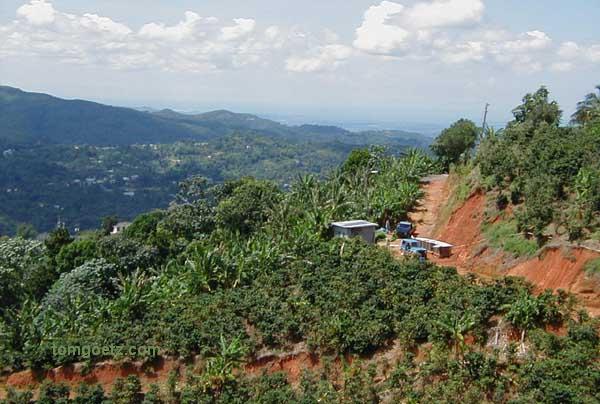
Near Maricao
After leaving town, we entered the Bosque Estatal de Maricao, a
forest of more than 10,000 acres south of Maricao. Vistas along the
road overlook both the south and west coasts of the island. We
stopped at a torre de observación which our book described as a
2,600-foot stone observation tower. I would call it a 40-foot
observation tower at a 2,600-foot elevation. Semantics, I guess. No
wonder I'd never heard this tower mentioned as the tallest building
on earth! You can see much of the western coast from here.
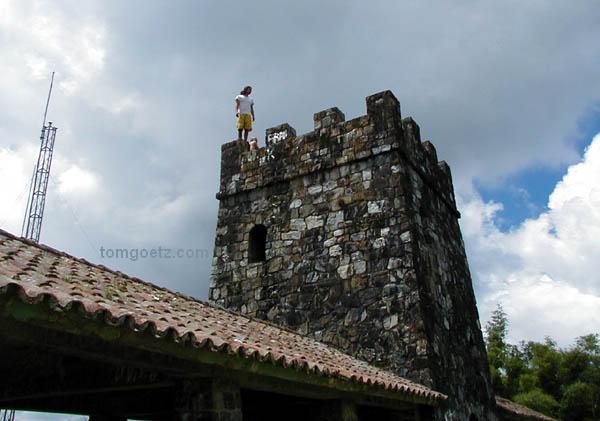
Torre de observación
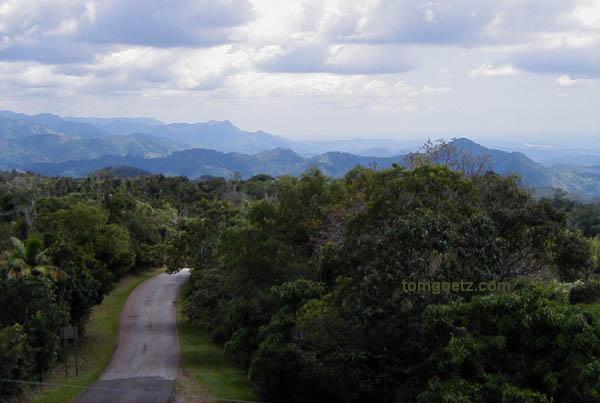
La Ruta Panorámica
We tried again for provisions at a market in the settlement of
Castañer and had better luck. Just outside of town we entered the
Bosque Estatal de Guilarte, 3,600 acres, and had lunch at a
beautiful, peaceful picnic area and scenic viewpoint near the
park's ranger station. Monte Guilarte, at 3,950 feet only 400 feet
shorter than the island's highest point, is one of the few peaks on
the island that isn't covered with communication towers.
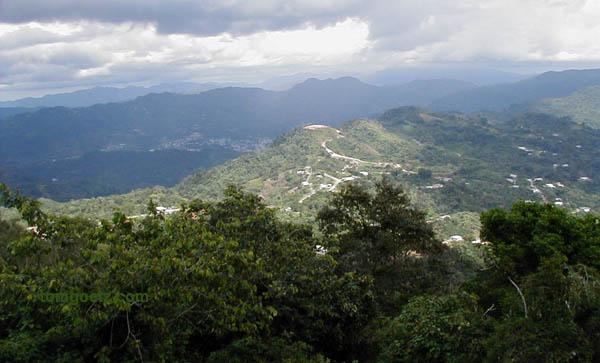
View from our picnic area!
There are no naturally-formed lakes in Puerto Rico. All the
lakes are reservoirs formed by damming the rivers. Just south of
Adjuntas, we drove past Lago Garzas, one of the island's smallest
lakes, when Tom saw something interesting and I turned the car
around. He described it as a "sinkhole dam." We've since learned
that this is a "morning-glory" spillway or a "glory hole," a
funnel-shaped outlet that allows water to bypass the dam when it
reaches capacity. We'd never seen one like this before, and it
looked very cool.
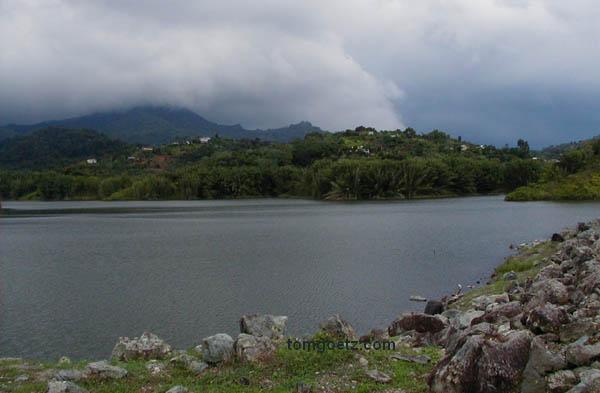
Lago Garzas
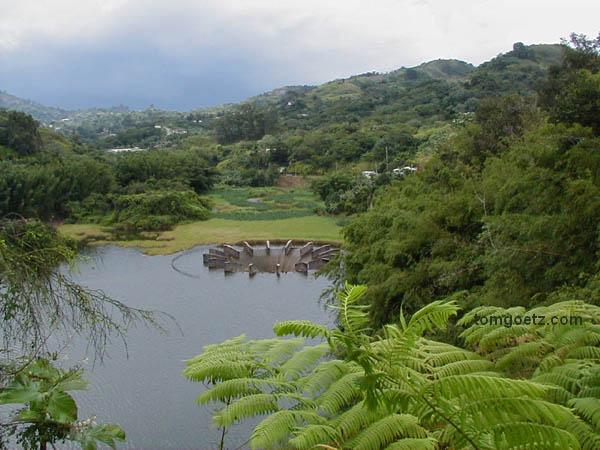
Morning-glory spillway
Shortly after Lago Garzas, it started to rain. We'd already
planned to stay the night in Adjuntas, the next town, so it didn't
much matter. Adjuntas is known both as "the town of the sleeping
giant" for the silhouette created by the surrounding mountains and
"the Switzerland of the Caribbean" for reasons that remain unknown
to us. We had the address of the place we wanted to stay, the Monte
Río Hotel, but no map of the town! I parked the car at the town
plaza, and we asked directions and walked to the hotel. The town is
a maze of one-way streets and heavy traffic, so I didn't want to
move the car till we knew where we were going. Monte Río was just a
block south of the plaza, and we quickly arrived. The room was $65.
By the time we checked in, it was pouring instead of just simply
raining, so we watched "Los Simpsones" (no English-language
television at this hotel) and waited for the rain to subside before
retrieving our car and luggage.
English is not so ubiquitous in Adjuntas as we'd experienced
thus far. The signs in our hotel were in Spanish only, and we had
to ask directions in Spanish. Also, we've found several instances
of Carribean Spanish differing from other Latin American Spanish.
For example, there were signs all over the hotel that said
"Desposite los desperdicios en el zafacon. Gracias." Well, they
said "please," and we'd be glad to comply, but we don't know what
in the heck they're asking us to do, and we're too embarrassed to
ask. After returning home we finally learned that "zafacon" means
wastebasket, and they were just asking us to put our trash in the
trash can. Don't worry - we did that even though we couldn't read
the instructions.
As another example, our pizza at Pizza Hut the other night came
with "setas." Then we saw something with setas on the menu at the
Chinese place. Tom asked what it was and one of the customers told
us mushrooms. We knew mushrooms as "champiñones." And as a final
note, I will just mention that now we know that "inodoro" means
toilet. That term may be used elsewhere, but we were
unfamiliar.
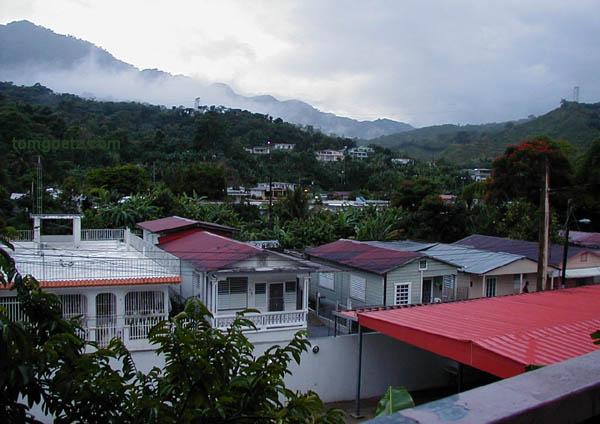
From our balcony at the Hotel Monte Río, p.m.
At 5:45 the rain stopped for a while and we went for a walk
around the plaza. Unfortunately, they seem to roll up the sidewalks
at 5:30. We couldn't even find any dinner, but we did find a
six-pack of Medalla Light, a Puerto Rican beer. It was pretty
decent, reminiscent of Coors Gold. We went to the hotel's
bar/"restaurant" for a bit, but they just had bar going on. Friday
night, and there were just nine people there, including Tom and I
and the bartender. The bad music on the jukebox soon drove us back
to our room, where we dined on chips and granola bars.
|






